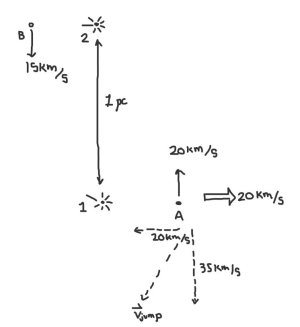The rules as written make sense to me. See the attached drawing for my interpretation.JTAS 3 pg12 states "The laws of conservation of mass and energy continue to operate on ships that have jumped; when a ship exits jump space it retains the speed and direction that it had when it jumped."
I think this is a bad thing and that the laws of conservation of mass and energy don't need to apply through Jump Space.
1) It leads to a lot of undesirable in-game possibilities
You are jumping from star system 1 to star system 2, relatively close by (on a galactic scale). Say the center of mass of star 1 and its planets is moving relative to star system 2 center of mass at 20 km/s in the x-direction. That's pretty typical of the relative velocity between stars in Charted Space.
Planet A orbits star 1 and is currently moving at 20 km/s along the y-direction relative to star 1. That's pretty typical for a planet in an orbit similar to Terra around Sol.
Planet B orbits star 2 and is currently moving at 15 km/s along the negative y-direction relative to star 2.
If you want to jump to an orbit around Planet B, you want to leave Planet A and enter jumpspace with a velocity vector that will cancel out the relative motion and give you a velocity vector that closely matches that of your destination, Planet B. In this case, you'd want to leave Planet A at around 40 km/s in the correct direction (vjump on the diagram). That's a little over an hour acceleration at 1 G. If the Astrogator's doing their job and the jump goes well, you should exit jumpspace at the right speed to enter an orbit around B, or close enough to make small adjustments when you get there.

